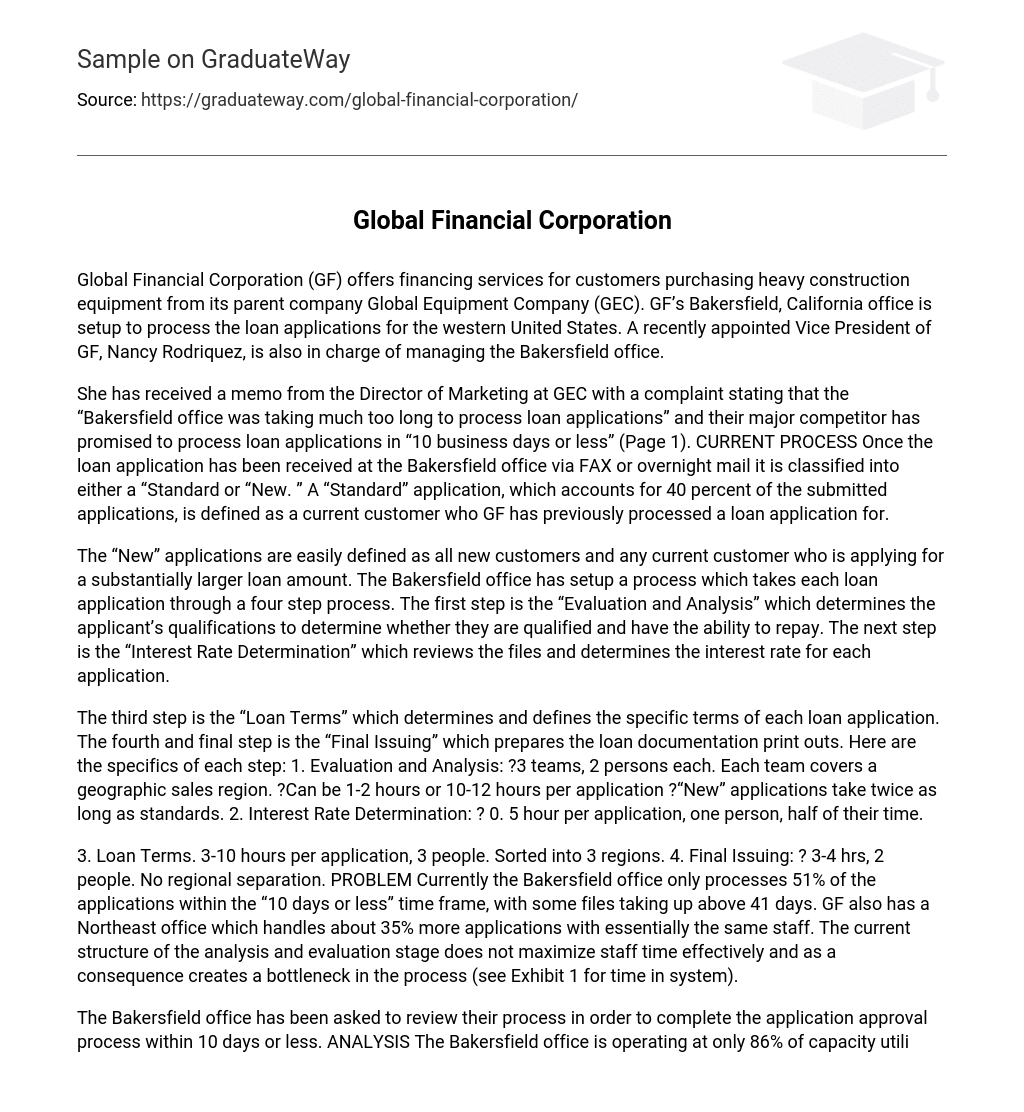Global Financial Corporation (GF) offers financing services for customers purchasing heavy construction equipment from its parent company Global Equipment Company (GEC). GF’s Bakersfield, California office is setup to process the loan applications for the western United States. A recently appointed Vice President of GF, Nancy Rodriquez, is also in charge of managing the Bakersfield office.
She has received a memo from the Director of Marketing at GEC with a complaint stating that the “Bakersfield office was taking much too long to process loan applications” and their major competitor has promised to process loan applications in “10 business days or less” (Page 1). CURRENT PROCESS Once the loan application has been received at the Bakersfield office via FAX or overnight mail it is classified into either a “Standard or “New. ” A “Standard” application, which accounts for 40 percent of the submitted applications, is defined as a current customer who GF has previously processed a loan application for.
The “New” applications are easily defined as all new customers and any current customer who is applying for a substantially larger loan amount. The Bakersfield office has setup a process which takes each loan application through a four step process. The first step is the “Evaluation and Analysis” which determines the applicant’s qualifications to determine whether they are qualified and have the ability to repay. The next step is the “Interest Rate Determination” which reviews the files and determines the interest rate for each application.
The third step is the “Loan Terms” which determines and defines the specific terms of each loan application. The fourth and final step is the “Final Issuing” which prepares the loan documentation print outs. Here are the specifics of each step: 1. Evaluation and Analysis: ?3 teams, 2 persons each. Each team covers a geographic sales region. ?Can be 1-2 hours or 10-12 hours per application ?“New” applications take twice as long as standards. 2. Interest Rate Determination: ? 0. 5 hour per application, one person, half of their time.
3. Loan Terms. 3-10 hours per application, 3 people. Sorted into 3 regions. 4. Final Issuing: ? 3-4 hrs, 2 people. No regional separation. PROBLEM Currently the Bakersfield office only processes 51% of the applications within the “10 days or less” time frame, with some files taking up above 41 days. GF also has a Northeast office which handles about 35% more applications with essentially the same staff. The current structure of the analysis and evaluation stage does not maximize staff time effectively and as a consequence creates a bottleneck in the process (see Exhibit 1 for time in system).
The Bakersfield office has been asked to review their process in order to complete the application approval process within 10 days or less. ANALYSIS The Bakersfield office is operating at only 86% of capacity utilizing 2990. 5 hours of processing time (full capacity 3485 hours). In the First Quarter 1996 they processed 218 applications, 89 were “Standards” and 129 were “News. ” The analysis by region (Exhibit 1) illustrates Region 1 is handling the most applications at 78 (52 New, highest number among the different regions), which equates to 37 days in the system.
Region 2 is only handling a total of 66 applications (35 new) with an average processing time of 7 days in the system, and Region 3 handling 74 applications (42 new), averaging 11 days. ALTERNATIVES Per Exhibit 2 under a generic model queue, the regions would be combined, with all loan applications sent to one location. Using the MMK model with the arrival and service rates noted, the estimated time is in the system would be approximately nine days.
Another alternative would be the case manager model (Exhibit 3), where each staff performs all the necessary steps in the loan application process. This assumes that the staff can be cross trained, in about a month. A month is presumed reasonable, as based on the data provided, the office would have approximately 75 applications to cross train on before the staff would be expected to meet the average times per the survey performed. RECOMMENDED SOLUTION Recommendation is to implement the above alternatives in a two phase process.
In the first phase, we recommend that the Bakersfield office move to a “Generic Queue” model where they would combine all of the applications and all of the servers of the regions. By removing the processing by regions, the number of days in the system is immediately reduced to less than ten days. In the second phase, we recommend that the Bakersfield office move to a “Case Manager” model where each employee is cross trained in all four steps of the approval process, and therefore takes an application from acceptance to completion.
By moving into the Case Manager model the number of days in the system is reduced significantly to approximately five days in the system (Exhibit 3). Moving to this model will also allow them to reduce their staff from fourteen down to eleven. With eleven employees they will still be able to easily meet the “10 days or less” requirement and operate at 90% utilization, which is derived from the MMK model using 228/22/11 assumptions. IMPLEMENTATION
Implementation consists of two phases. Phase one would be to remove the processing by regions requirement and require all teams to process applications as they are received (generic queue process). Phase two implementation will cross train staff over a period of one month by rotating each employee through all four of the application approval steps, while in the generic queue model, in order to prepare them to become a Case Manager, handling the entire loan application themselves.





